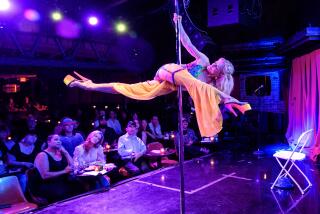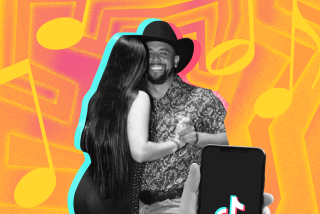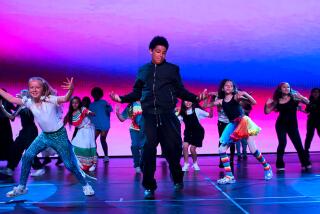Unlikely Instructor of Exotica : Dance Teacher Shakes the Myths Out of Hula
- Share via
SAN DIEGO — Everyone knows that grass skirts, bare midriffs and wildly gyrating hips are trademarks of the hula. Or are they?
Not so, says Barbara Finneran of Pualani’s Hula Studio. During a break from teaching an advanced class of hula dance students in Mira Mesa, Finneran explained the common misconceptions about this exotic art form.
“Hula dancing doesn’t have those frenzied vibrations of the hips, and it isn’t danced in halters and grass skirts. That’s what people believe, because they watched ‘Hawaii Five-O.’ ” Each episode of the long-running television series began with a fleeting mosaic of sexy island dancers shaking their torsos violently to the relentless pounding of native drums.
“Actually, what people think of as the hula is really Tahitian dance,” said Finneran. “The hula is from Hawaii, and it has even, flowing motions. It’s usually danced in long mumus (Hawaiian dresses), pa’u (cotton skirts), or ti leave skirts (which resemble grass skirts).”
Finneran, who conducts classes in hula, Tahitian, and other dance expressions from the South Pacific Islands and New Zealand, is known to her students as “Auntie” Barbara, and she dotes on them just like a member of the family. Her students (there are about 75 right now) range in age from 3 to 72. They learn the cultural history of the dances as well.
At least a dozen of the advanced students perform as a group in supper clubs or at special functions. The ensemble has even appeared in concert for the San Diego Area Dance Alliance at its annual festival.
Finneran, a prim-looking, middle-aged woman with wire-framed eyeglasses, seems an unlikely teacher of exotica. There is no Hawaiian in her heritage--hula dancing was an adopted passion. Finneran only discovered the art form during the ‘60s, when her husband was stationed in Hawaii with the military.
“I went to a hula class with a girlfriend--just to keep her company. She never went back and I kept going,” Finneran recalled. “I just had a natural knack for it.”
Soon Finneran was performing and teaching classes of her own on the island, and when her husband retired to San Diego in 1975, she picked up where she left off.
“I teach the dancing, but I also teach everything about the culture. We have classes on the history and the instruments. Like so many cultural dances, these tell stories too using a complex gestural language. We learn everything--not just the showy stuff,” she noted.
During the lessons, Finneran stands solidly in front of the class strumming tunes on the ukulele or tapping rhythms on a native drum, while her students sway gently to the beat. Sometimes the dancers provide their own musical accompaniment with gourds or bamboo sticks, rapping their instruments as they maneuver through the tricky patterns in their bare feet.
Often, the percussives are pounded out on drums or hollowed logs by assistants (including Finneran’s daughter, Karen) seated on the sidelines. Finneran herself fervently chants the librettos, and despite the modern surroundings, the classes take on the aura of a religious ritual performed around an ancient jungle fire.
Hula “almost died when the missionaries came to Hawaii. They considered it too descriptive and too earthy,” Finneran explained. “It can be very explicit and very sensuous.”
During those years of repression, the hula moved underground, and it wasn’t until Hawaii’s King Kalakaua brought it back into favor in the late 1800s that the hula became an accepted art form again.
“The ancient hula is more stern--it’s not as soft as the modern version. The hula has changed a lot over the years, but now the ancient forms are having a revival,” said Finneran, who is intent on preserving the old and the new.
Every dance has its own lyrics and music, but unlike most forms of dance, the hula allows many interpretations.
“The choreography isn’t written,” she said. “Each teacher uses her own. Except for the old dances, which are traditional, the poetry is free in the hula. It’s open to emotions and very interpretive.
“You choreograph a lot of different steps and gestures, and the hand movements tell the stories. The shoulders never move like they do in jazz. The emphasis is on the hips--they must move in a graceful, smooth line. But the dance always looks different when it is expressed by different choreographers.”
Karen Stine, a 29-year-old student in the senior class, was born in Hawaii, where she began her hula training. Now she performs with the group and continues her lessons as a link with her heritage.
But neither Sheila Jackson (who assists Finneran with the teaching chores) nor April Reynoso has ancestral ties to Hawaii. They’re both drawn to the hula, because they “love doing it.”
Finneran teaches a wide repertory of modern hulas; the stark, ancient version, and the hapa-haole, a fusion that combines traditional and contemporary styles into a new form.
In the “Auia,” a dance that has remained intact since about the 13th Century, the libretto warns, “hold on to your heritage”--a lesson that brings bitter memories to the Hawaiian people. However, through Finneran’s work, the cultural riches of Hawaii are spreading to this side of the Pacific, where they are being passed on to people from every ethnic background. Finneran has amassed an impressive collection of plaques, trophies, and awards for her skill and devotion to this cause.
Finneran is determined to prepare her students in the art of putting on a performance as well.
“I try to teach (the students) how to handle shows by themselves, so sometimes I don’t even go with them (to performances). I want them to learn as much as they can, so if I should drop dead, they can go on by themselves,” she said, only half in jest.
More to Read
The complete guide to home viewing
Get Screen Gab for everything about the TV shows and streaming movies everyone’s talking about.
You may occasionally receive promotional content from the Los Angeles Times.






